A hooligan at heart, the latest Speed Triple 1200 RS comes brimmed with brains to help you make the most of its brawn… Who better to test it? Our own Bruce Wilson…
It’s three decades since Triumph rewrote the rulebook and created the performance naked sector with their T309 Speed Triple. Since then, the iterations have come thick and fast, the performance figures have gone through the roof, but the ethos behind the scantily clad renegade have remained very much true to form. While it’s not the British brand’s best seller, over 110,000 Speed Triples have rolled off Triumph’s production lines… and that’s a figure that’s likely to get a whole lot higher following the introduction of this prime cut of British beef.
Building on the firm foundation of the 1200 RS that hit the market back in 2021, the 25-spec Speed has taken the model’s sophistication to a whole new level. Think more evolution than revolution, with perhaps the most salient of differences being to the tech on the bike.
Enjoy everything More Bikes by reading the MoreBikes monthly newspaper. Click here to subscribe, or Read FREE Online.
The big news is the introduction of Ohlins’ third generation, semi-active SmartEC3 suspension, making this the first bike we’ve tested in the supernaked sector to get these goodies. It’s a proven system that’s so far been the preserve of high-end sports bikes, so its fitment to the Speed is something that really deserves shouting about.
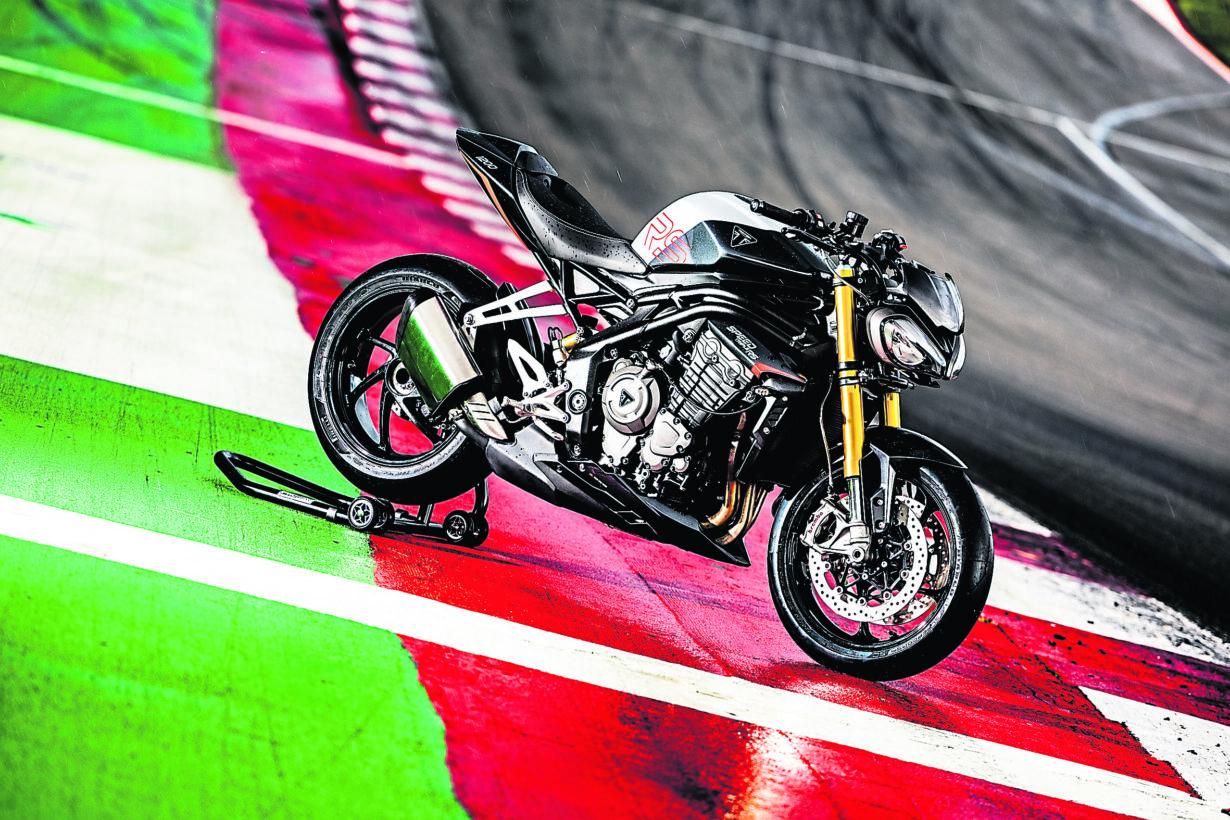
Why have Triumph gone down this route? Well, it was a surefire way of making the bike as suited to bumpy back lanes as it is at smashing lap times on a billiard-smooth racetrack. And to give it even more of an edge, other technological advancements include a MotoGP-derived shifter and blipper package, the introduction of stepped engine brake management and, for the first time, the fitment of a separated wheelie control package that allows you to switch between four different levels of loft, from tame to outright ASBO.
Add into this mix cruise control, heated grips, slide control, cornering ABS, plus power modes, and you’ll appreciate the Triumph’s now fully loaded with features, including a customisable 5” colour dash that plays host to tech such as alterable rider modes, power maps and cornering traction control. Even the ABS is switchable, with a new Track-spec function in place for those that demand they get the best from the bike’s Brembo Stylema calipers, that are paired with a fancy Brembo MCS master cylinder.
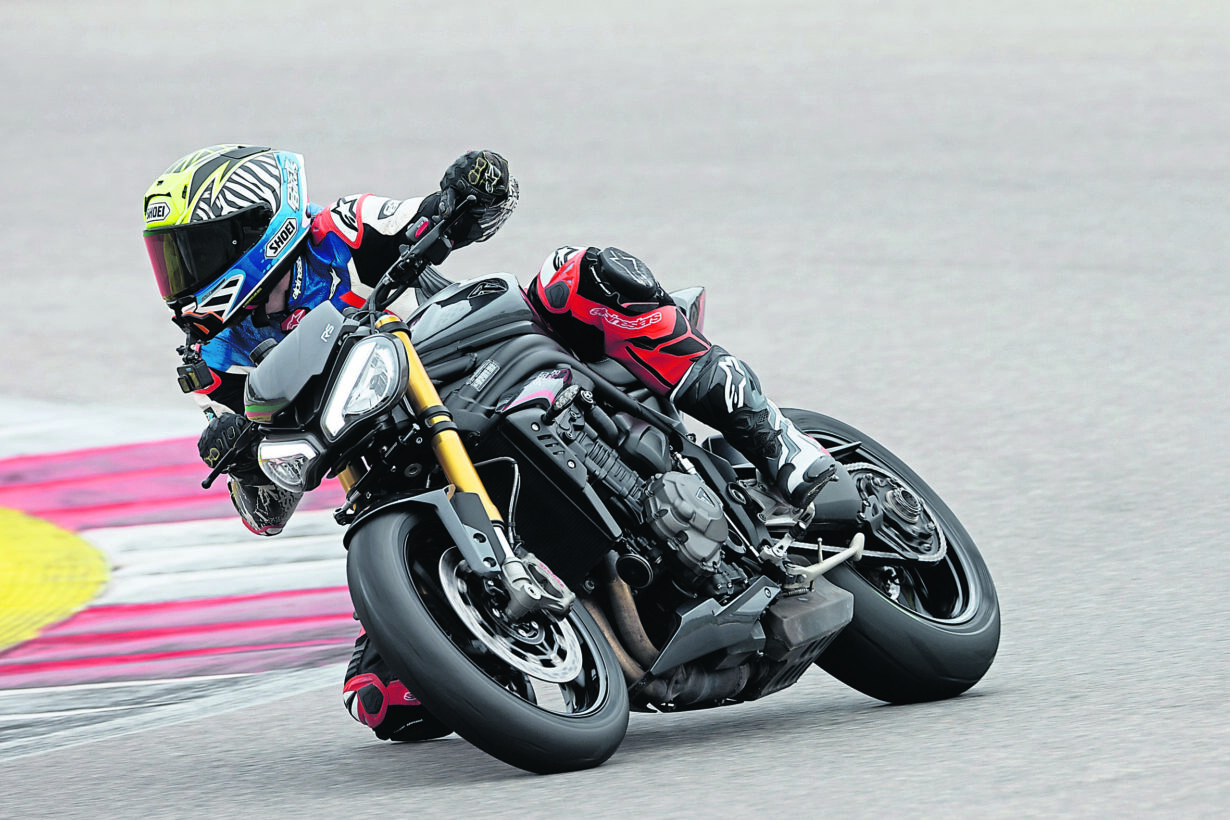
So, those are the new model’s techy highlights, but there have also been lots of other enhancements to the Speed in other areas. For instance, the Triumph’s now gained a fork-mounted steering damper, while the bars have been made taller and wider to make the ride more comfortable and that bit easier to lever into bends.
While the mass of the machine has actually gone up a kilo over the last version, there’s an abundance of new parts that should have made that figure much higher. To help in that department, new lighter wheels have found themselves on board, plus a lithium battery. The actual frame, swingarm and overall geometry of the bike remain the same because it wasn’t broken in the first place; the engine’s now producing 3bhp more peak power, with an extra 3Nm of torque, that kicks in 250rpm lower than before.
How so? Well, that’s mainly down to the exhaust package because it’s much freer flowing, despite being cleaner than before. Internally, the balancing of the crank has meant that delivery is smoother than ever, thanks to the adding of around 20 grams of material, that’s then blueprinted as needed to ensure performance perfection from this key player in the motor. What this means is the Speed’s now Triumph’s most powerful production bike they’ve ever released, with a claimed output of 180.5bhp, backed up by 128Nm for good measure.

While the torque figure’s unquestionably impressive, there were a few people on the model’s launch in Portimao that threw it out there that some of the Speed’s supernaked rivals had upwards of 20bhp more than the Triumph… so why hadn’t they gone all in on the motor to squeeze a whole lot more from the Triple? The answer was a straightforward one: they didn’t want to.
There’s no doubt about it that with some different cams and a shift of performance from the midrange, more peak could have been achieved. That kind of thinking makes sense on a race bike, but the Speed’s road-focused origins dictate that it has to perform at its best in that environment first and foremost… even if it means theoretically being second best in the power stakes department to more top-end inclined rivals. Having had this explained to us, we were asked to judge the bike’s performance on what we felt, not what we read, with a comprehensive two-day test on road and track lined up for the taking.
First up was a day at Portimao racetrack, which is a circuit I know and love. Fast, flowing and with plenty of scope to assess the Triumph’s power, handling and braking performance… the only thing we were missing was a bit of decent weather. We awoke to a circuit that was drenched, and mechanics flat-out changing the bike’s tyres to Pirelli wets. I was gutted, but also trusting in the bike’s chassis engineer who was adamant that a good time was still to be had, alongside a potentially even more thorough evaluation of the bike’s tech.
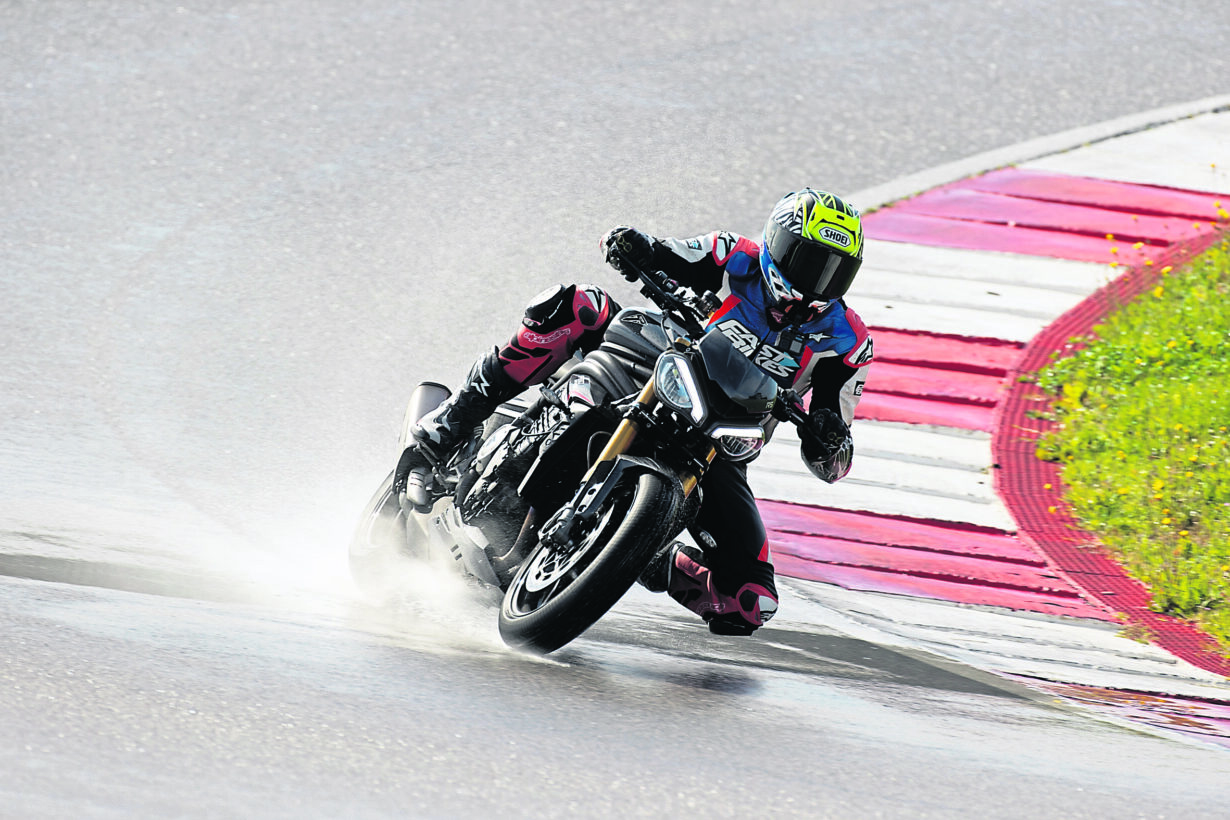
Proving this point, everyone’s bike had been dialled in to make the package as user friendly as possible, with the suspension set to its ‘comfort’ position (meaning the damping had been backed right off to make the bike supple), while the ABS got switched to ‘road’ (most intrusive) and the traction control was set on ‘rain’ (in a bid to prevent me high-siding at the first corner… again). And with that, we were off, lapping up the puddles and getting our first thoughts on the Triple.
I’ll save you the session-by-session shenanigans, but needless to say that within a few outings I had got my eye in and was loving life behind the bars of this brute. There’s a lot to like about the Speed, with perhaps the engine being a real high point. The track’s silly fast down the start straight, seeing high revs in sixth gear before you back off the throttle and go for the anchors. Getting up to speed is a real joy because the bike’s power delivery is so linear, so smooth and made effortless to extract thanks to the slick operating shifter system. Add into that mix an epic soundtrack, that only gets better when back-shifting, and you’ll know why that start straight experience was a joy with every lap clocked.
It wasn’t just the straight-line section that got my juices flowing, however, as I learned on each and every bend that the motor’s so pliable and usable, regardless of whether you’re pushing out of a second gear bend, or holding a steady degree of drive as you moderate the throttle marginally when navigating some of the most demanding sections of the track. The final corner on the circuit is an absolute mind-twister, and especially so in the wet, where you’re powering on in fourth gear at big lean, downhill, just waiting for the moment to go all in and pull the pin as the corner exit arrives and the start straight appears.
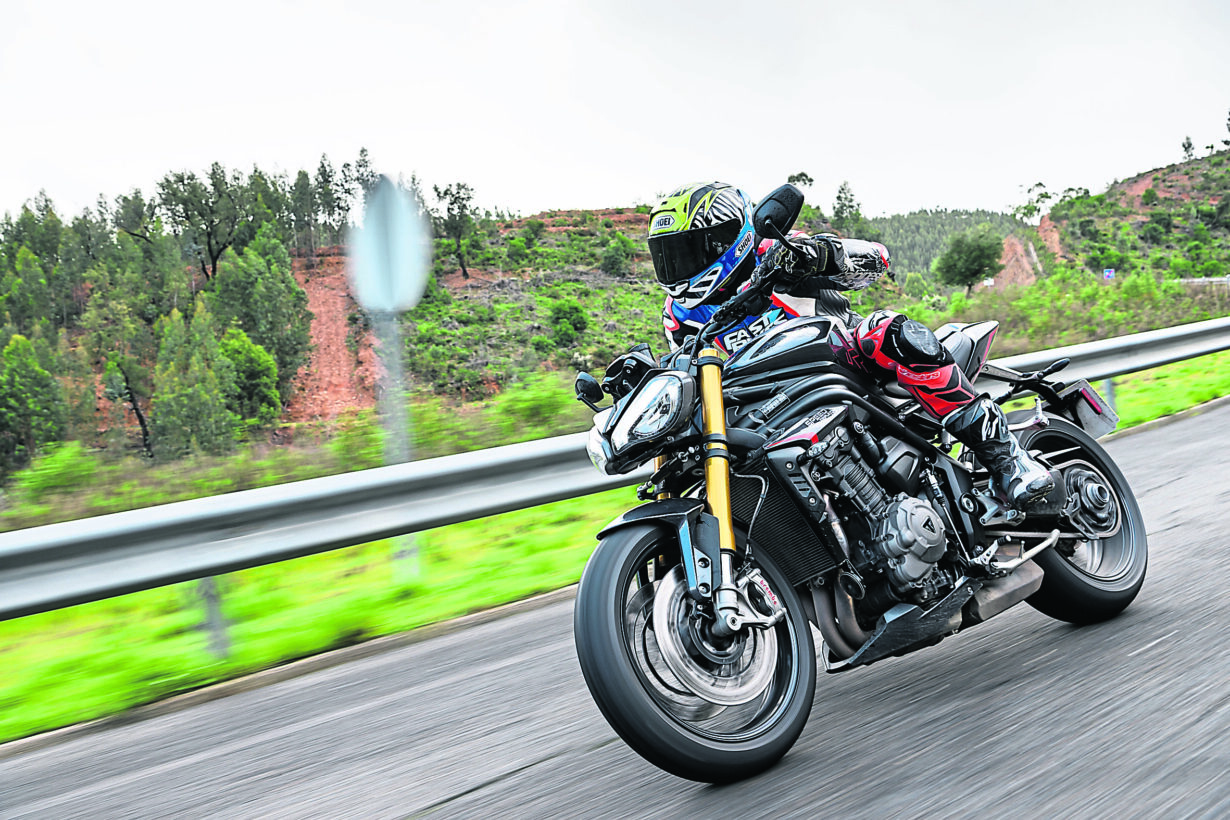
A smooth operator is the order of the day, and if you’re tainted with a lumpy, snatchy or hunting motor, this particular bend would show up all its weaknesses, and either leave you mentally scarred for life, or perhaps facing a stint in hospital. That corner takes no prisoners, and I was super-mindful of that when relishing the smoothness and flow of the bike’s motor.
Of course, with time on my hands and an ever-growing confidence, it hadn’t taken too long for those initial base settings of the machine to wear thin and become a little frustrating. For instance, the cornering traction control meant that at big lean there was zero chance of high-siding, as the tech culled the power delivery, regardless of whether the throttle was back to the stop. Stand the Speed up, and the drive would kick back in, but way later than I wanted it.
In ‘track’ or ‘rider’ mode, you can alter the set up on the fly, so weaning the TC engagement off became a real priority for me. A switch to ‘road’ mode was better, and ‘sport’ even more so, but it wasn’t until I got the level into ‘dynamic’, the least intervening of the lot, that I truly felt happy. I’d still see the TC light flash on the dash, but much more sporadically, and the comfort blanket of limiting drive at lean was now pretty much null and void. I was on my own, responsible for my own mistakes, yet knowing that if I really took the mick, the system was likely to kick in and save the day… or so I hoped.
Another area I worked hard on throughout the test was the handling of the bike. It’s been a year since I last rode on wets, and on that occasion, at the very same track, I destroyed a bike and gained a dislocated finger. That was a performance I wasn’t in a hurry to replicate, so my progress was steady, making sure I had a good grasp of the bike before tweaking away at the Ohlins.
The problem was, owing to the soft nature of ‘comfort’ mode, the damping on tap was actually making the bike sketchy. Even in the wet I was still up at nearly 300kph before squeezing hard on the Brembos, squatting the bike on its nose and leaving the forks at the bottom of their travel. The third-gear first corner arrives on the scene soon afterwards, and while the initial pitch into it was fine, the bike would then run wide, and even more so when getting on the gas. In essence, more support was needed… and not just a little of it.
As per the traction control scenario, I went through the process of switching through the different levels of pre-programmed suspension support, feeling the improvement of ‘normal’ before settling on ‘dynamic’. With that inset, the bike’s pitch on the brakes was far less notable, and the agility and stability of the Triumph was on a whole different level.
There was the option to have gone into altering the bike’s set up even more so, asking for additional support under deceleration, acceleration, cornering and for general firmness, but on the damp track, a little bit of suppleness, made all the sweeter by the ever-changing characteristics of the auto mode, was far more appealing. Had the track of been dry and with consistent grip levels, I’d have been all over the multitude of set up options that were on the cards, but ‘dynamic’ proved to be everything that I needed.
Knee down was effortlessly achieved, and throwing the bike in and out of bends was up there with stealing cake from a fat kid with tied shoelaces… easy-peasy. The thing I liked best of all was the very telling nature of the handling package. There was never a time that I felt caught out by the level of traction available, or surprised by a sudden sensation from the tyres that I hadn’t expected. I can’t pinpoint whether that’s purely down to the feel of the Ohlins or the talkative chassis, or even the telling rubber, for that point, but what I can say is everything worked together nicely.
By the sixth and final session of the day, I was loving life in the puddles, riding at a fair old lick and with very little concern. Throughout the course of the day, I’d not just learned to trust in the Speed’s tech, but to actively push myself and the limit of every single corner.
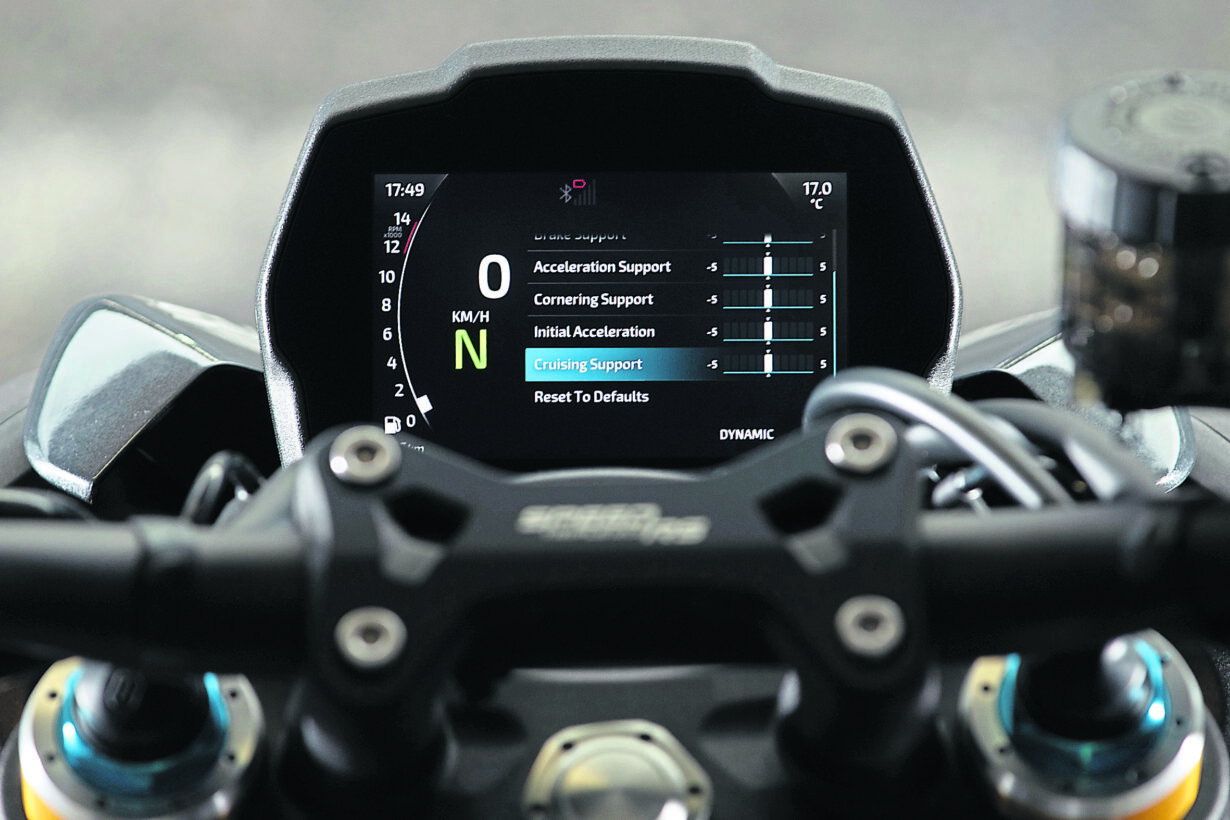
Despite finishing the day on a high, it was impossible to ignore that the real test for the Triumph was going to be out on the roads the following morning. Inevitably, we had a massively wet day on the cards and the prospect of getting drenched, with zero weather protection, let alone a screen, had me questioning my life choices.
It was hammering it down as we left base and trundled off towards the first shoot location, nestled high in the stunning Algarve. It’s at this point I should mention we were riding on the bike’s stock tyres, which are Pirelli Supercorsa SPs.
If you’re unfamiliar with them, the first thing to know is they’re pretty lacking in tread, being more inclined towards fast road and track riding than inclement conditions. As you’d expect, the traction was loaded back to rain mode, the power was weaned right off, and the suspension was set to comfort… it was like déjà vu from the day before.
Following the lead rider, his lack of hesitation only egged me on into trusting the bike and the tyres that little bit more, conceding that if his bike could do it, so could mine. Inevitably, the TC light was flashing like a pelican crossing and there were lots of moments where I felt the power culled to calm my overly ambitious ways, but I was soon having a blast. That said, with the heavy rain had come a lot of debris, littering the roads and making them look more like a motocross track at times, and probably even slicker. If ever there was a time for the bike’s systems to earn their crust, this was it.
With the first shoot in the bag and my boots wetter than a fish tank, the ride cracked on and we were blessed with the occasional patch of dry roads. In an instant, the ride would go from survival mode to a full-on assault, bidding to extract the brutal brilliance of the Triple’s motor at every given moment.
We’d only ever get a mile or two before we were back on wet roads, but during those spells we had succinct windows to reaffirm what we’d learned the day before on the track: this bike handled fantastically, could stop impressively, and that the engine on the Triumph made the whole package an absolute treat.
As you’d imagine, our revs often ran a great deal lower on the road than they ever did on the track, but regardless of whether I was simply pulling away from a junction or gassing out of a hairpin bend, the triple was effortlessly on hand to get the bike up to speed, never stuttering, hesitating or lacking in excitement. Not only was there never any dawdling from it, but the smoothness and table manners of the engine rendered it up there with the best of them in class.
I’m not going to turn this into a slagging match, calling out other bikes and questioning their principles, but what deserves hammering home is that the usability of the Triumph made life so brilliant and effortless on the roads. And, of course, the Ohlins suspension made the job a whole lot better. Riding everything from back roads to carriageways, we undertook every kind of lump and bump imaginable, but there were also lots of fast and smooth sections for us to tackle.
On the whole, ‘comfort’ mode made great sense, but on the more spirited, dry bits I never hesitated to taught things up on the fly, dialling in ‘road’ or ‘dynamic’ from the predetermined menu options. You could literally feel the bike transform, with added support and capabilities as a consequence. In those fleeting moments, when the conditions were in our favour, the genius of this potent roadster really won me over. I only wish we’d of had more of those windows, but it wasn’t to be.
With 100 miles of riding in the bag, we arrived back at base, wetter but wiser… and ready to take on a wheelie session down Portimao’s start straight. With the weather so bad the day before, our scheduled appointment to try out the bike’s tiered wheelie system went out the window, so this unexpected opportunity demanded no persuasion for every man and his dog to try out the tech.
Told to simply pin the throttle, lean back and trust in the system, I was eventually doing just that. It was nothing short of mind boggling to appreciate how effortlessly the tech made each and every one of us a wheelie god before the crowds staring over the pit wall.
There was no thought of a balance point, no moderating of the throttle necessary, and as for covering the rear brake to avoid flipping it, there was simply no need. Ironically, the people who got on best of all with the system were the ones who had less ability at pulling wheelies naturally, with one or two such folk sitting on the back wheel for the length of the start straight. It was hard not to be impressed, and it was nice to end the Speed Triple launch on such a high, with a lot of people having ticked a box they’d have never thought possible.
Triumph aren’t the first to offer such a feature to the market, but they’re one of the first, and considering the nature of this high-powered headbanger, I can imagine it will prove an allure to those debating which supernaked to put their money on.
The truth is, the Triumph’s got some serious competition out there, but it very much delivers the goods and perhaps in a more versatile way than most of its competition. From the riding position to the tech, the performance to the great handling, there was a lot to like about this bike, and I for one can’t wait to get back on one. Preferably in the dry.
Specs: Triumph Speed Triple 1200 RS
Engine
Type: 1160cc, triple cylinder, liquid-cooled
Bore x Stroke: 90mm x 60.8mm
Compression: 13.2:1
Fuelling: EFI
Claimed Power: 180.5bhp @ 10,750rpm
Claimed Torque: 128Nm @ 8750rpm
Chassis
Frame: Aluminium twin spar
F Suspension: Fully adjustable, 43mm Ohlins SmartEC3
R suspension: Ohlins SmartEC3 monoshock with adjustable rebound, compression and preload
Front brakes: Brembo Stylema, four-piston monobloc calipers, 320 discs
Rear brake: Twin-piston caliper, 220mm disc
Electronics
Riding Modes: Yes
Traction Control: Yes
ABS: Yes
Quickshifter/Autoblipper: Yes
Wheelie Control: Yes
Launch Control: No
Dimensions
Wheelbase: 1445mm
Seat Height: 830mm
Wet Weight: 199kg
Fuel Capacity: 15.5 litres
Info
Price: £17,495 From: www.triumphmotorcycles.co.uk


